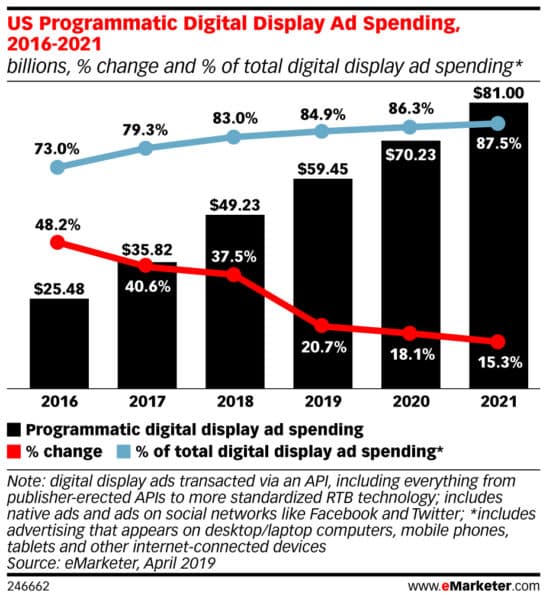Programmatic Advertising: Automated Bidding, Buying, and Selling of Online Ads
Source: https://martech.org/what-you-need-to-know-about-programmatic-advertising/
Much like advertisers bidding for positions on search engine results, online advertisements themselves are also often sold by hosts to advertisers by auction. The massive size and scale of the web, with billions of websites and an incalculable number of individual web pages, however, makes manual auctions for ad space ineffective. Instead, most auctions for online ad space are performed automatically via a system known as programmatic advertising. This year, programmatic advertising is projected to be responsible for more than 90% of the entire digital display ad market – producing ad revenue exceeding $115 billion.

Programmatic advertising involves an input of preset bid values from buyers that are automatically compared (with the largest bid chosen) every time online ad space is available. Advertisers must thus decide how much they are willing to bid (and how much space they are willing to buy) beforehand. Most often, the whole auction process occurs as soon as a user opens a website with ads. The Ad space is put up for auction, bid on, and sold to the bidder with the highest bid value almost instantaneously in a process called Real-Time Bidding. Usually, online ad space, including ad space sold programmatically, is priced by cost per 1,000 ad impressions (CPM).
Although the actual auctions occur instantaneously whenever a user opens a web page with ad space, the principles in programmatic adverting auctions are the same as any other sealed-bid auction we have discussed in class – each bidder prepares a bid with the maximum value they are willing to bid in advance, with no knowledge of the values of other bidders or how many other bidders there are, and then the bidder with the highest value is chosen. The source article for this post does not indicate whether the auctions are first-price or second-price, although lessons from class indicate that a second-price auction, wherein the highest bidder wins but pays the value of the next highest bidder, would be preferable for the sellers of online ad space, since second price auctions make bidding one’s actual value a dominant strategy, while first-price auctions incentivize bidding slightly lower than one’s actual value to maintain a surplus. Thus, sellers of online ad space would maximize their returns by running programmatic second-price auctions where advertisers are incentivized to bid the actual CPM value they assign to that ad space.
